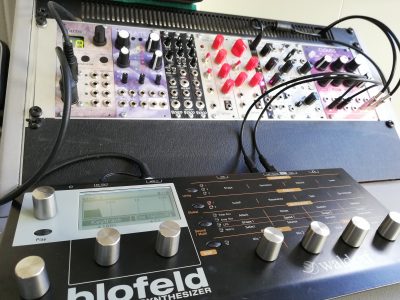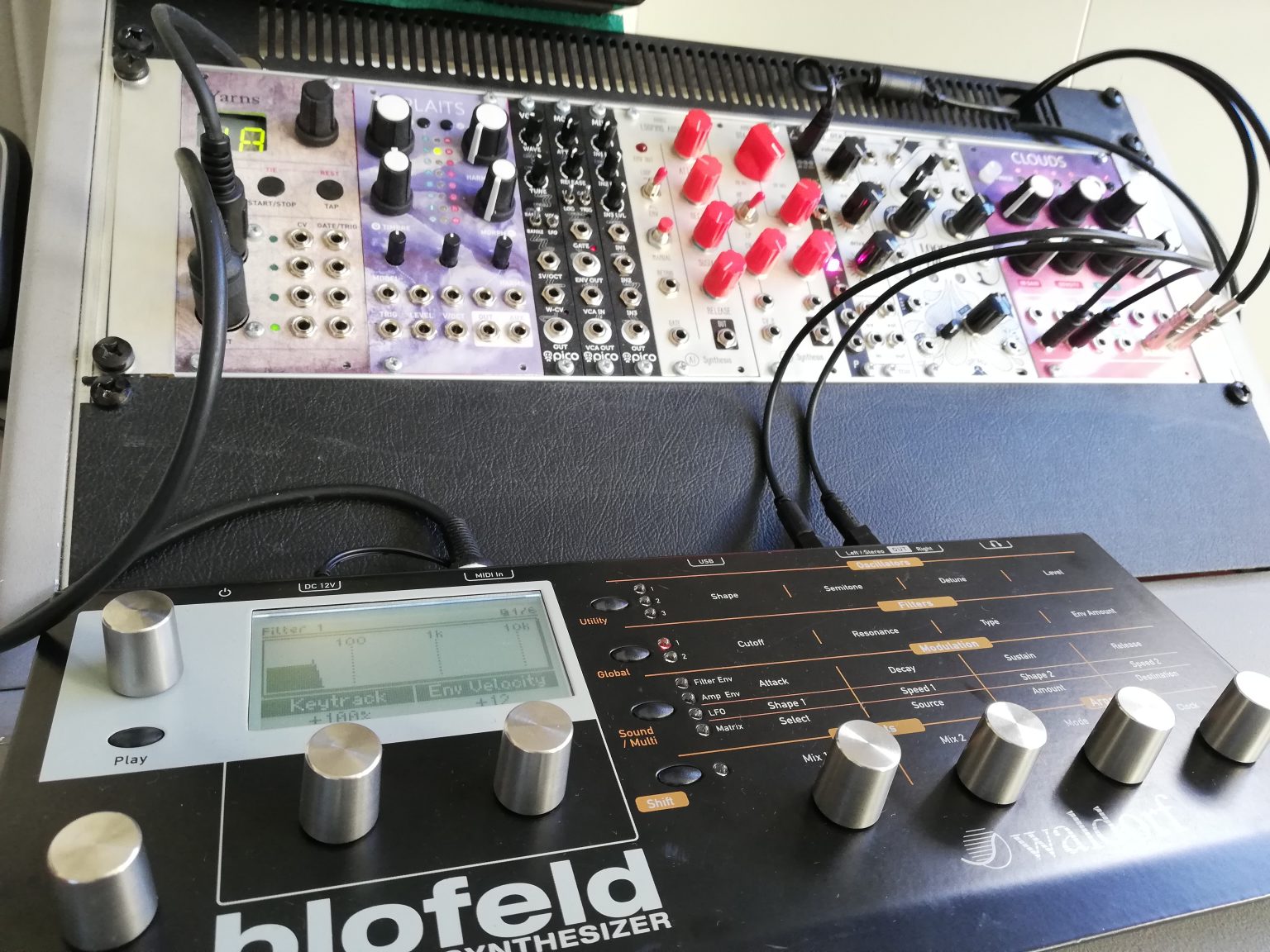This is the last part of the series on how I made my first DIY Eurorack setup. In Part 1 I talked about the modules and the case, while in part 2 I explained a little bit about the problems I went through when building the modules. This article is about my setup, how it works and how I use it.
Make sure to follow the video below, which shows you all the patches described in this article.
Basic Signal Flow of a Subtractive Synth
My setup is basically a simple subtractive synthesizer. Let’s think about that for a second. The signal flow for a subtractive synth would be like this: note input > oscillator > filter > amplifier (VCA) > effects > output.
Patch 01: Midi Input
In my case, Yarns was used as a note input. It can take up to 4 midi inputs and put out 4 monophonic outputs, 2 duophonic outputs or 1 polyphonic output. (Plaatje yarns modes). For my first patch, I was using Yarns in monophonic mode which means each incoming midi note was translated into 1 cv (pitch) output and 1 gate or trigger output.
Gate vs trigger
Now, what is the difference between gate and trigger you might think? Gate is a timed pulse. If you press and hold a key on a midi keyboard Yarns would translate that to a high voltage. Releasing the key would output 0 volts. A trigger, however, is just a tiny little pulse that sends out a high voltage and then goes back to 0 volts for a fraction of a second. So what’s the practical difference? A gate allows you to hold a note down (sustain) while a trigger doesn’t. Triggers are generally used for percussive sounds. An acoustic drum doesn’t have a sustain you can control so it makes more sense to use a trigger for these kinds of sounds.
The Oscillator
Now that we have a midi input translated to both a pitch and gate output we can connect the pitch cv output to an oscillator. In my system, both Plaits and the Pico VCO can be used as oscillators. Most oscillators in Eurorack divide their pitches on a 1 volt per octave fashion. One semitone is, therefore, 1/12th of a volt.
Each oscillator has a frequency or tune knob. This is used to tune the oscillator like you would tune a guitar. Both my oscillators are digital and can be tuned in semitones. Analog oscillators, on the other hand, can be tuned to an infinite amount of pitches which makes them a bit harder to tune.
Both oscillators have lots of different modes and waveforms. A basic subtractive synth usually has a sinewave, square wave, saw, and triangle option. Plaits is a multifunctional beast that includes FM synthesis, additive synthesis, a chord mode, and even drum synthesis. This is why plaits also has a trigger input. The trigger input can be used to restart it’s internal envelopes when using the percussive modes.
The Pico VCO doesn’t have a trigger input and will output a constant uninterrupted tone. Playing on your keyboard now will change the pitch but not the amplitude of the notes.
Patch 02: ADSR Volume Control
In order for our little Eurorack synth to only make a sound when a key is held we need to use an envelope generator in conjunction with an amplifier. This is where we use our gate output of Yarns. The gate output goes to the gate input of the Looping ADSR. Every time you press a key, the envelope start’s it’s attack and decay cycle. As long as you hold the key down the envelope will stay in it’s sustain phase. When you finally release the key the envelope generator will enter it’s release phase to slowly fade out the signal.
In order to hear this ourselves, we need to connect envelope output to the input of the amplifier. In my case, this is the Manhattan Analog DTA.
We’ve used 4 modules until now and all we’re getting is a simple oscillator sound that responds to our midi keyboard. In a subtractive synthesizer, these are the things you don’t need to think about because they are hard patched by the manufacturer already. The fun thing about modular is that we now have the opportunity to go beyond the basics and patch everything we want.
Patch 03/04/05: LFO, AM Modulation
Need a tremolo effect? Simply add the output of the Pico VCO in LFO mode and connect it to the second input of the DTA. Or you could use the Aux mode of Plaits for interesting amplitude modulation effects. Send your LFO to a passive mult and split the signal to your DTA or VCA and the Harmonics input of plaits at the same time. Now you will start to see the endless possibilities modular synthesis offers.
Adding a filter
Patch 06: Manual Filter Control
Let’s continue with our patch and add a filter. The output of the oscillator goes into the input of the filter which in turn goes to the input of the DTA. Now you can filter the signal manually with the cutoff knob.
Patch 07: Control both filter and volume with one envelope
If you’d put the envelope output into a mult you can send it to the DTA and filter at the same time thus controlling both with one envelope.
Patch 08: VCA into a filter
You could also change the order by going through the DTA first and then into the filter. Experimentation is key with modular. Happy accidents are around every corner and that’s why you should always record everything you do.
Effects
Patch 09 and 10: Waveshaping and Granular Reverb
I have 2 effects in my system: Clouds and Loose Fruit. Clouds is the only stereo module I have so this is the last module in my chain. Loose Fruit tracks the pitch of incoming signals so it functions best with dry signals. This is why I sometimes use Loose Fruit before the filter as filtering will change the way Loose Fruit responds. But again, the signal flow is totally up to you.

Other Eurorack Modules
The Pico Mix can be used wherever you like. I often use it to mix 2 oscillators together before going into the filter. Other times I use it to blend the output of Loose Fruit with the dry signal. I often use Pico Mod as an amplitude envelope because it only provides attack and release control, which is fine in most cases.
This system provides me with more sounds than I could have ever imagined getting out of such a small system. I did quickly realize I have a lack of modulation options. I have tons of stuff to modulate but not enough LFO’s and Envelopes to modulate with. However, some modules like Yarns provide extra oscillator outputs which can be used as LFO so patching strategically helps me find unique sounds.
If you like to learn more about modular Eurorack synthesis, take a look at the following YouTube channels:
DivKid: https://www.youtube.com/channel/UC1zIiKvJIi7aYl2N68pWF8g
Mylarmelodies: https://www.youtube.com/user/hello6am











